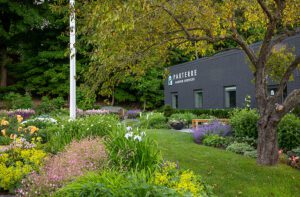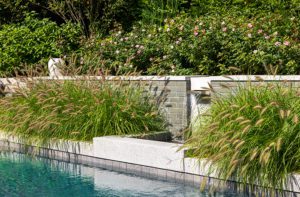European Elegance in Cumberland Maine
May 10, 2018
A classic, somewhat grand exterior masks the understated interior of a Maine home built to enfold its inhabitants in contentment and ease.
Text by Debra Judge Silber Photography by Jeffrey R. Roberts
The journey from wish list to dream home gets complicated fast. So there’s something to be said for keeping the process simple by entrusting it to a single professional who stands by you all the way through, from floorplans to framing to furnishings.
Nicola Manganello isn’t an architect or a builder. But her firm, Nicola’s Home, specializes in guiding residential projects from imagination to reality. She elicits design ideas from her clients, commits them to paper, and has the plans reviewed by an engineer. She then oversees the home’s construction, lining up all the necessary subcontractors. “We manage everything,” says Manganello, who spent two decades fixing and flipping vintage houses around Portland, Maine, before founding her eponymous firm.
In 2008, she bought a tract of land in Cumberland Foreside, an old community about ten miles north of Portland that had developed a fresh cachet among homebuyers. It became Maeve’s Way, a signature development Manganello named for her daughter.
Her custom-designed dwellings drew a number of admirers, among them Lori and Chris, a couple who were looking for a change from the golf community they’d been living in. The pair fell in love with the neighborhood and its carefully crafted houses. With the youngest of their three children still at home, they wanted a place where the entire family could congregate to enjoy each other and the activities they like: swimming, tennis, and working out.
They looked at an existing house in Maeve’s Way, but it wasn’t quite right. “We needed to tweak a few things,” Lori explains, such as enlarging the mudroom and adding a second master suite downstairs. “We want to grow old in this house, and wanted the option of being able to live on the first floor.” A larger lot to accommodate a pool and tennis court was also on the wish list.
So Manganello found a double lot, and pulled out her pencil as Lori and Chris shared their vision. Lori described the house in her head as European in style, with a French flair reminiscent of country chateaus of the Loire Valley, a house that would reflect the family’s love of travel as well as their yearning for a snug home base. It would be spacious, but relaxed rather than extravagant. “I don’t like wasted space, and I love cozy,” Lori says.
As Manganello sketched, a design emerged for a classic, 6,000-square-foot home marked by two large gambrel-roofed gables, one intersected by a fieldstone chimney. A long, metal-roofed porch supported by tapered columns stretches the length of the front. Near the center, the slightly recessed entry is flanked by two intentionally oversize columns. “I work with scale a lot,” she says. “The columns had to be bigger to compete with the rest of the house. In a house this large, you need some defining, big moments.”
The front door is not actually the defining moment here, however. That distinction belongs to the entrance to the property itself, an arched opening through a 2,000-square-foot garage. This structure offers some of the recreational space the family wanted while also enabling Manganello to incorporate a design concept she’d been eager to try. With two parking bays on the ground floor and a large recreation room and fitness studio on the second floor, the structure provides for the family’s dual passions: automobiles and athletics (the whole family enjoys sports, and Lori is a former fitness coach who teaches tennis).
For Lori, the garage-gatehouse concept reinforced a connection to the French estates she loved. “Nikki said it was something she always wanted to do, and we were so on board with it. It lends itself to some elegance. I thought, ‘I would love that.’ ”
Despite the formal approach, the interior is relaxed and casual. “On the outside, they wanted a little bit of opulence,” Manganello says. “But inside they wanted it to be warm and understated.”
The home expresses its lack of pretension in the heavily checked hemlock beams that crisscross the ceiling of the combined family room and kitchen, in sliding barn doors, and in the use of reclaimed wood and rugged stone surrounding the multiple fireplaces. The range of materials implies an authenticity lacking in the cookie-cutter “traditional” style of the clients’ former home.
Texture, not color, carries the interior. “She wanted a clean look, a lot of neutrals,” Manganello explains. The subtle colors that do appear were suggested by the striped sisal stair runner that Lori chose from Stark. “The runner was one of the first things she picked, and it was a driving factor in the colors in the house,” the designer says.
Furniture emphasizes comfort, from the paired ninety-plus-inch sofas in the family room to the tufted armchairs and king-size bed in the upstairs master, where all are welcome and where a built-in coffee and tea station encourages lingering—if not in the bedroom itself, then on the outdoor balcony that overlooks the pool and hot tub. A common lounging area in the center of the second floor (“the flop room,” Manganello calls it) offers yet another hang-out space that balances sociability and seclusion.
Directly below, the dining room’s placement in the center of the house reflects an arrangement Lori saw in another Manganello home. Both its location and the comfort of its upholstered chairs are a nod to frequent guests. “They entertain a lot, and they end up sitting at the table for a long time, so comfortable chairs are important,” the designer says. The firebox is raised, bringing the flames nearly even with the table top a few feet away.
The designer papered the walls of the dining room, the adjacent entry foyer, and upstairs master suite with grasscloth. “I’m big with paper right now,” she says. “I like the way it brings color and texture and dimension. It enhances everything around it.”
For the first-floor powder room, she opted for an ikat-patterned paper that coordinates with geometric embellishments on the vanity. Like many pieces in the house, the vanity was sourced through
Manganello’s treasure trove of furniture, fabrics, and accessories housed in a restored barn in nearby Yarmouth. There, she and her clients chose many of the unique furnishings that would complete the process of transforming a personal vision into a unique home. “We left no stone unturned,” Manganello says. “And I think it shows. This home envelopes you.”
Project Team
Architectural and interior design: Nicola Manganello, Nicola’s Home
Builder: Island Cove Building and Development
Share
![NEH-Logo_Black[1] NEH-Logo_Black[1]](https://b2915716.smushcdn.com/2915716/wp-content/uploads/2022/08/NEH-Logo_Black1-300x162.jpg?lossy=1&strip=1&webp=1)




















You must be logged in to post a comment.